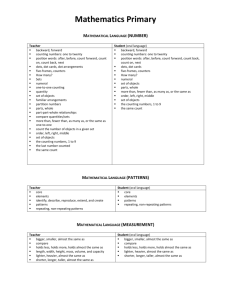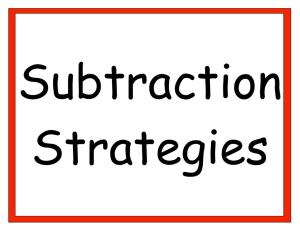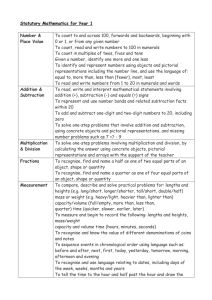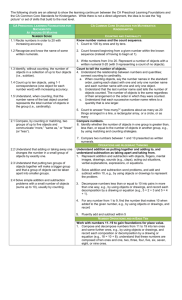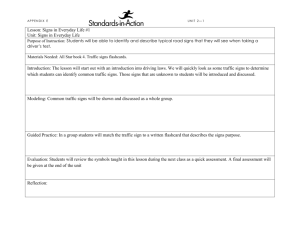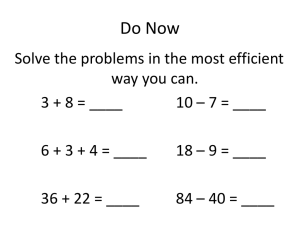Years P–2 Numeracy Indicators - Queensland Curriculum and
advertisement
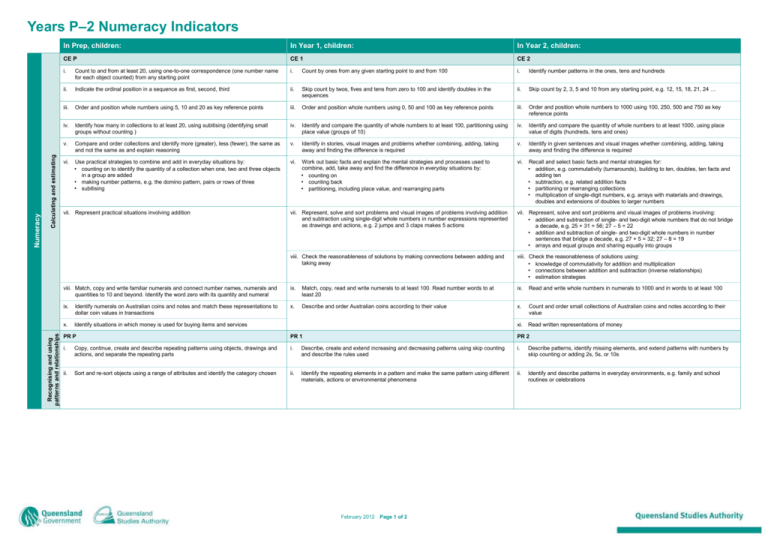
Calculating and estimating Recognising and using patterns and relationships Numeracy Years P–2 Numeracy Indicators In Prep, children: In Year 1, children: In Year 2, children: CE P CE 1 CE 2 i. Count to and from at least 20, using one-to-one correspondence (one number name for each object counted) from any starting point i. Count by ones from any given starting point to and from 100 i. Identify number patterns in the ones, tens and hundreds ii. Indicate the ordinal position in a sequence as first, second, third ii. Skip count by twos, fives and tens from zero to 100 and identify doubles in the sequences ii. Skip count by 2, 3, 5 and 10 from any starting point, e.g. 12, 15, 18, 21, 24 … iii. Order and position whole numbers using 5, 10 and 20 as key reference points iii. Order and position whole numbers using 0, 50 and 100 as key reference points iii. Order and position whole numbers to 1000 using 100, 250, 500 and 750 as key reference points iv. Identify how many in collections to at least 20, using subitising (identifying small groups without counting ) iv. Identify and compare the quantity of whole numbers to at least 100, partitioning using place value (groups of 10) iv. Identify and compare the quantity of whole numbers to at least 1000, using place value of digits (hundreds, tens and ones) v. Compare and order collections and identify more (greater), less (fewer), the same as and not the same as and explain reasoning v. Identify in stories, visual images and problems whether combining, adding, taking away and finding the difference is required v. Identify in given sentences and visual images whether combining, adding, taking away and finding the difference is required Use practical strategies to combine and add in everyday situations by: vi. Work out basic facts and explain the mental strategies and processes used to combine, add, take away and find the difference in everyday situations by: • counting on • counting back • partitioning, including place value, and rearranging parts vi. vi. • counting on to identify the quantity of a collection when one, two and three objects in a group are added • making number patterns, e.g. the domino pattern, pairs or rows of three • subitising Recall and select basic facts and mental strategies for: • addition, e.g. commutativity (turnarounds), building to ten, doubles, ten facts and adding ten • subtraction, e.g. related addition facts • partitioning or rearranging collections • multiplication of single-digit numbers, e.g. arrays with materials and drawings, doubles and extensions of doubles to larger numbers vii. Represent, solve and sort problems and visual images of problems involving addition and subtraction using single-digit whole numbers in number expressions represented as drawings and actions, e.g. 2 jumps and 3 claps makes 5 actions vii. Represent, solve and sort problems and visual images of problems involving: • addition and subtraction of single- and two-digit whole numbers that do not bridge a decade, e.g. 25 + 31 = 56; 27 – 5 = 22 • addition and subtraction of single- and two-digit whole numbers in number sentences that bridge a decade, e.g. 27 + 5 = 32; 27 – 8 = 19 • arrays and equal groups and sharing equally into groups viii. Check the reasonableness of solutions by making connections between adding and taking away viii. Check the reasonableness of solutions using: • knowledge of commutativity for addition and multiplication • connections between addition and subtraction (inverse relationships) • estimation strategies viii. Match, copy and write familiar numerals and connect number names, numerals and quantities to 10 and beyond. Identify the word zero with its quantity and numeral ix. Match, copy, read and write numerals to at least 100. Read number words to at least 20 ix. Read and write whole numbers in numerals to 1000 and in words to at least 100 ix. Identify numerals on Australian coins and notes and match these representations to dollar coin values in transactions x. Describe and order Australian coins according to their value x. Count and order small collections of Australian coins and notes according to their value x. Identify situations in which money is used for buying items and services xi. Read written representations of money vii. Represent practical situations involving addition PR P PR 1 PR 2 i. Copy, continue, create and describe repeating patterns using objects, drawings and actions, and separate the repeating parts i. Describe, create and extend increasing and decreasing patterns using skip counting and describe the rules used i. Describe patterns, identify missing elements, and extend patterns with numbers by skip counting or adding 2s, 5s, or 10s ii. Sort and re-sort objects using a range of attributes and identify the category chosen ii. Identify the repeating elements in a pattern and make the same pattern using different materials, actions or environmental phenomena ii. Identify and describe patterns in everyday environments, e.g. family and school routines or celebrations February 2012 Page 1 of 2 Using fractions, decimals, percentages, ratios and rates Using spatial reasoning Interpreting and drawing conclusions from statistical information Numeracy In Prep, children: In Year 1, children: In Year 2, children: FDPR P FDPR 1 FDPR 2 i. i. i. Identify a whole and its parts Use materials and visual representations (linear, region and group) to represent: • a fourth (half of a half, quarter) as any one of four equal parts of a whole • an eighth (half of a fourth) as any one of eight equal parts of a whole SR P SR 1 SR 2 i. Identify, sort and describe: • 3-D objects (cubes, cylinders, spheres and cones) in everyday environments, using straight and curved surfaces and number of faces • typical representations of common 2-D shapes (circles, triangles, rectangles including squares) • non-typical representations of triangles and rectangles i. Classify 3-D objects (pyramids, prisms) using geometric properties, e.g. number of faces, vertices (corners) and edges. Classify 2-D shapes embedded in everyday environments using geometric properties i. Classify familiar 3-D and 2-D shapes using key features ii. Visualise and describe key features of 3-D models, counting faces, corners and edges. Describe straight and curved lines, and draw 2-D shapes (triangles, kites, rhombuses, circles, rectangles including squares) with and without technologies Describe own spatial position relative to an object or familiar location in the environment using everyday language, e.g. between, near, next to, forwards and towards. Follow and give single, routine directions ii. Use positional language to describe: • the position of an object in two different ways • two different pathways to get to a familiar location using: clockwise, anticlockwise, forward, under, and turns iii. Represent and interpret simple maps of familiar locations on a grid, describe locations of key features. Follow and give directions using positional language, e.g. right, left, forward, back, number of spaces, full-, half- and quarter-turns iv. Visualise and identify one-step transformations (slides, flips, half- and quarter-turns) with and without technologies v. Identify viewpoints (top, front, side and back) of 3-D objects ii. SI P SI 1 (Not a focus in the Australian Curriculum at this level) i. Identify situations where events are random (may not always occur as expected) and classify them using the language of chance, e.g. will happen, might happen, might not happen, won’t happen, certain, impossible i. Describe the likelihood of outcomes of practical activities and everyday events using the language of chance, e.g. likely, unlikely, impossible, certain i. ii. Represent and interpret data by: • choosing simple questions and gathering responses • constructing object/people/picture graphs where one object or drawing represents one data value • describing similarities and differences using the comparative language: not many, greatest and least number ii. Represent and interpret data by: • identifying an issue or question of interest based on one categorical variable • collecting data using a range of methods including tally marks • using drawings, tables and lists to sort, classify and check information • creating displays using lists, tables and picture graphs (one to one correspondence), with and without technologies • comparing the usefulness of different data displays • describing the data presented, combining categories as required • comparing responses with predictions Represent and interpret data by: • collecting information in response to questions that can be answered yes or no • sorting materials and people into groups that match responses to a given question or issue MP i. Using measurement Identify and describe a half as either of the two equal parts of whole collections and lengths SI 2 M1 Use direct and indirect comparison and describe the relationship between different attributes using comparative language, e.g. longer, taller/shorter, bigger/smaller, holds more/less, heavier/lighter M2 i. Measure and compare, with and without technologies: • lengths, using multiple repeats of uniform informal units and attending to gaps and overlaps • capacities of pairs of objects, using uniform informal units i. Compare (directly and indirectly) and order by: • length and height using uniform informal units, e.g. hand spans and pieces of string • area, volume and capacity using appropriate uniform informal units • mass using uniform informal units on balance scales ii. Make reasonable estimates of length using mind pictures of different uniform informal units ii. Make reasonable estimates for measurements and describe the strategies used when given a uniform informal unit ii. Identify points in time that are of personal significance iii. Identify hour and half-hour times iii. Read quarter-hour time, using: past the hour and to the hour iii. Arrange aspects of daily routines in sequence iv. Describe durations using months, weeks, days and hours iv. Order days of the week, months of the year and seasons, and identify the number of days in each month iv. Name days of the week and connect them to familiar events and actions v. Distinguish between past, present and future using the language of time, e.g. a long time ago, then and now, now and then, old, new, yesterday, last night and tomorrow v. Use a calendar or timeline to identify duration of time in months, weeks, days and hours, and dates of events Years P–2 Numeracy Indicators Australian Curriculum v.3 Queensland Studies Authority August 2012 Page 2 of 2

